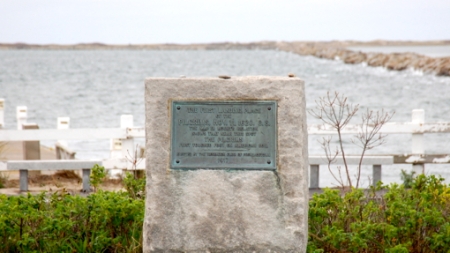
 Pilgrims’ First Landing Park
Pilgrims’ First Landing Park
The rotary at land’s end is the site of the First Landing Marker, which rises from an apron of commemorative and memorial paving stones. It was originally placed here in 1917 by members of the Research Club, an antiquarian minded group of Mayflower descendants that had been founded seven years earlier at 84 Bradford Street. They based their dubious assertion about the landing spot on a map in an 1865 edition of A Relation or Journal of the Beginning and Proceedings of the English Plantation Settled at Plymouth in New England, by Certain English Adventurers, Both Merchants and Others, published in London in 1622 and better known as Mourt’s Relation, after the typographically corrupted name of the author of its preface: George Morton.

Though the account itself was firsthand, written by William Bradford and Edward Winslow, the map didn’t exist until two-and-a-half centuries later, when it was appended to a new printing of Mourt’s Relation, edited by the Rev. Henry Martyn Dexter, a Congregational minister in Boston. This map, Clive Driver wrote, has “been cited, all too often, as totally authoritative, when, in point of fact, it is an informed 19th-century attempted reconstruction.” (“‘Mourt’s Relation,” The Provincetown Banner, 7 November 1996.) With its plain references to Telegraph Hill and Stevens Point, however, the map certainly satisfied a popular hunger for an X to mark the spot of a celbrated moment in American history.
After the Pilgrim tercentenary, the marker seems to have fallen somewhat from civic consciousness, until it was covered by underbrush on the Murchison property, 2 Commercial Street, to which it had been ignominiously consigned.

After World War II, when it was possible to think about public works again, Ralph Carpenter, who lived at 11 Commercial Street and was the founding proprietor of the nearby Delft Haven cottage colony (7 Commercial and 10 Commercial), took it upon himself — as a committee of one — to rescue the marker. He designed and constructed an entirely new setting in 1947-1948, described extensively in the Scrapbooks of Althea Boxell. A newspaper account speaks of it as a 17-by-50-foot plaza, rhomboid in plan. The marker was placed in a 24-foot, flagstone-paved apron, flanked by beds of Cape Cod roses and surrounded by brick piers and a wrought-iron fence.
On the brick piers at either side of the marker were bronze plaques fashioned in 1947 by William Boogar (1893-1958). These were inscribed with the concluding verse of “The Landing of the Pilgrim Fathers in New England” by Felicia Dorothea Hemans:

Ay; call it holy ground,
The soil where first they trode.
They have left unstained, what there they found —
Freedom to worship God.

Carpenter’s plaza lasted less than a decade. It was uprooted in 1956 by the expansion of the Provincetown Inn. In Looking Back, published in 2004, Driver wrote that the Boogar plaques had “disappeared.” However, I stumbled across them in 2009 — entirely by accident — while walking near the Winslow Street tanks. Hard to see at first, their patinated surfaces stained and mottled, the plaques were mounted low to the ground in a front yard full of maritime memorabilia at 45 Captain Bertie’s Way. Paul Mendes, who salvaged and cared for the plaques, had no idea where they had come from originally. When he learned, he donated them to the Pilgrim Monument and Provincetown Museum. (Pru Sowers, “Pieces of Provincetown’s History Rediscovered,” The Provincetown Banner/Wicked Local, 15 October 2010.)

These days, the text of the First Landing Marker has a great deal of competition underfoot for visitors’ attention. Sponsored granite paving stones ($300 for up to 20 characters; an additional charge for more) and granite bench tops have proved to be enormously popular with donors. They are also a worthwhile, engaging, communal narrative about what Provincetown values and what its people have witnessed in recent years; from the AIDS epidemic to the earliest same-sex marriages in America. Some of the inscriptions are jaunty enough to induce a smile, others are poignant enough to make a tear or two feel irresistible. Others are — undoubtedly as intended — a bit too cryptic for anyone to decipher who is not mishpocheh; messages intended for a very few, even in this most public place. • Map ¶ Updated 2013-08-05
